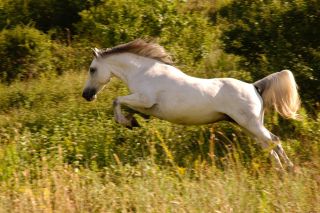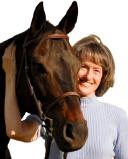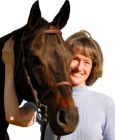Education
Learning About Trust by Observing Horses
Observing suspicion in prey animals can be useful for improving trust in humans.
Posted February 21, 2023 Reviewed by Ekua Hagan
Key points
- Horses exemplify the wisdom that it takes years to build trust, but only a moment to lose it.
- Prey animals, such as horses, are skittish and suspicious—and so are victimized human beings.
- By applying prey behavior to victimized humans, the nature of trust can be better understood.

There’s nothing like a prey animal to teach humans how to trust. Prey animals, like horses, are skittish. They’re suspicious of potential risk. Their brains are wired to leap away from new items or unexpected events without considering the actual risk involved from a rational point of view. Equine brains also do not categorize new stimuli in the way human brains do—a familiar object that is suddenly experienced in a different context or from a different angle is unreliable. It's as unreliable as it would be if it were brand new and had never been experienced before.
Why? Because horses’ prey brains survived over evolutionary eons by being suspicious of anything unfamiliar. Those who weren’t skittish enough were eaten for dinner by hungry predators. The horse has a vested interest in withholding trust, much like a victimized human being does. We humans can learn a lot about trust by observing horses.
Horses notice everything. They observe their environments very precisely, and they react to tiny changes that most humans never notice. When horse people want to know whether something has changed around our homes or ranches, we just hop on a horse and ride around. The horse will point out every novelty. Maybe the hose was wound the wrong way last night, or a mounting block has been moved.
Consider this example. I used to ride in an arena with a horse trailer parked next to it. White plastic covers protected the tires on that trailer, blocking them from the sun, rain, and other corrosive elements. A bunch of us rode in that arena on a daily basis, so the horses knew the scene very well. They’d worked alongside the trailer for years.
One day, our horses were suddenly afraid of the trailer. Some ran backward, some froze in horror and refused to move, some leaped sideways, and a few walked past but with their bodies and necks bowed way out to the side. Out of about 20 horses, every one of them displayed some indication of unease. What the heck?
Upon close inspection, a few of us riders noticed that the white tire covers had been replaced overnight. The new covers looked identical, the same brand and size, but they were black instead of white. Every horse noticed the change, but several riders couldn’t figure out why their horses were so spooky. White to black on a tire; that’s all it took for suspicion and protective behavior to hijack our horses’ well-trained minds.
By observing horses and applying their prey behavior to victimized humans, we can get a much better grasp of trust: why it is so fragile, how it is lost by the tiniest stimulus, and how it can be regained. Horses are so big that they magnify fear to degrees that humans see very clearly. By contrast, humans have every reason to hide their fears, so we often don’t realize just how scared or distrustful another person might be until it’s too late. We make a mistake in our treatment of that person, and only then become aware—by their reaction—of what we have done.
I train horses to trust humans and humans to trust horses. In doing so, I’m made aware every day of how hard it is to gain a huge prey animal’s trust. If that prey animal has been abused, the problem is that much worse. Years of consistent daily training are needed to build a bond between a horse and a human. And it can all be lost in one moment. The same is true of human beings who have endured trauma or failed to develop strong attachments early in life.
If you deal with people—and we all do, right?—please learn from the horse just how easy it is to scare them away. Recognize that you don’t know what other people are feeling—they might appear to be completely confident and self-assured, even arrogant, while inside their hearts are racing and their minds are approaching a dead faint. Horses can run away from these problems, but humans often can’t. Soften your approach. Give them time and space. Take it easy.


